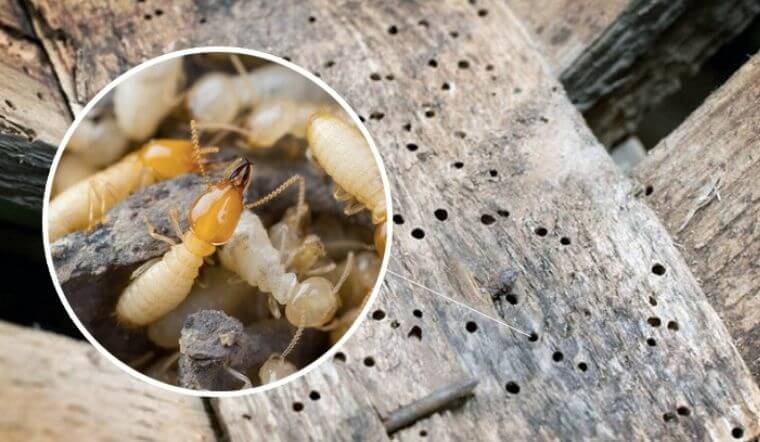1. Overview of Termites:
Termites are insects closely related to ants, with soft bodies, often gray/brown or white – they may resemble “white ants” upon casual observation. Termites are destructive insects to construction works, even to essential human belongings.
Woodworms are hard-shelled beetle insects with strong jaws, often brown or black, slightly grayish. Woodworms specialize in damaging various cereals such as rice, beans, and wood…
The main food of termites is cellulose – that is why wooden items are often attacked by termites, which, if not carefully handled, can cause significant damage.

2. 5 Ways to Prevent Termite Infestation for Wood:
“Prevention is better than cure” – Preventing termite infestation from the early stages will yield higher effectiveness and prevent damage to your household furniture. Especially in areas with a history of frequent termite attacks, these are the tasks you should not overlook to prevent termite infestation in your home.
2.1. Avoid letting wooden items come into contact with water, hot, and humid areas
Wooden items when in contact with water are prone to dampness, affecting the quality, durability, and aesthetics of wooden items. Therefore, you should limit leaving towels/water on wooden items, use soft towels to dry immediately after use.
2.2. Regularly clean wooden items is the best way to prevent termite infestation
Use a soft, non-fiber cloth to clean the cabinet immediately after use to prevent moisture and keep the wooden cabinet beautiful and new over time. Do not use wet towels to wipe the cabinet as it may fade the paint and water can seep into the wood, causing damage to the cabinet. Do not use cleaning chemicals to avoid damaging the cabinet.
2.3. Using good quality wood will contribute to termite prevention
It is advisable to use wood from reputable brands, processed carefully against termites before being processed into furniture such as moisture-resistant MDF wood, super moisture-resistant HDF wood, Picomat plastic, WPB plastic, etc. These cabinets are often reasonably priced, durable, with many designs, high quality, and less prone to termite infestation.
2.4. Brushing varnish on the wooden surface to prevent termites
Brushing paint or varnish on wood will make the door newer, creating a temporary protective layer for the wood so that termites cannot penetrate. Typically, wooden items after a period of use are prone to termite infestation. Repainting makes the wooden items look newer and avoids termite infestation.
2.5. Using essential oils to prevent termites
Termites usually like the smell of wood, dampness but dislike the smell of lemongrass essential oil. Lemongrass essential oil contains active ingredients such as citral and geraniol that help prevent termites. Moreover, lemongrass essential oil is extremely safe, so you can use it with confidence in wooden frames to contribute to preventing termite infestation for your wooden items.
3. 8 Ways to Treat Termite for Wooden Furniture:
Treating termites is a mistaken eradication work against termites that have caused and are causing harm to your furniture. This work should be done as soon as possible to avoid the most damage. Furniture after being treated for termites needs to be combined with preventive measures in section “II. 5 ways to prevent termites for wood” to avoid the case of termite re-infestation and damage.
3.1. Sun-dry items under sunlight
One of the best ways to treat termites is to sun-dry items eaten by termites under sunlight, the drying time may be 2-3 days. Termites usually like moldy and dark places – so drying under sunlight and dry is one of the effective ways to treat termites. However, this method can only be applied to loose furniture and has just been invaded by termites.
3.2. Use kerosene to treat termites
Kerosene is a chemical often used to treat termites in folklore. When detecting wooden items being eaten by termites, you put kerosene directly into the termite holes while spraying directly into kitchen cabinets, hinges, doors… Doing this continuously for about half a month will treat termites.
3.3. Use boric acid to treat termites
Boric acid is a compound commonly found in antibacterial solutions – this is also a chemical that can be used to treat termites. You can use a pack of boric acid powder bought at a chemical store mixed with water and sprayed into places with termites, it will effectively treat termites for wooden furniture.
3.4. Use salt to treat termites
In folklore, people often use salt to treat termites because this method is quite effective and safe. The treatment is very simple, just sprinkle salt on the path or directly sprinkle on the termite nest, the termites will go by themselves.
3.5. Use vinegar and lemon to treat termites
Using white vinegar mixed with lemon juice to spray into the termite nest or the places where termites appear is also an effective and safe method to treat termites.
3.6. Use lime to treat termites
In folklore, people often use lime to treat termites. There are two ways to use it: sprinkle lime directly into the termite nest or mix lime with water and pour it into the termite nest.
3.7. Lure termites with cardboard
Termites often like paper, cardboard. You can use a piece of cardboard to lure termites – when they go up to eat the cardboard, take it away and burn it, then place another piece of cardboard. Doing this several times will kill all termites.
3.8. Use termite bait and traps to treat termites
If you have tried all the above methods and still cannot treat termites, then use termite bait and insecticides – buy at pest control stores. However, usually, termite insecticides are quite toxic and need to be used carefully, so they are usually not suitable for families with young children. You should research the chemicals and read the instructions carefully before using this option.
Through this article, we hope to help you prevent and treat termites for wooden furniture in your home most effectively.
Cre: hancorp






















































































































































